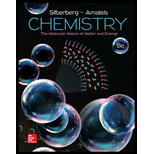
(a)
Interpretation:
The change in temperature has to be mentioned in order to yield more products and also the effect of temperature change on K has to be explained.
Concept Introduction:
Le Chatelier principle states that, whenever a change in temperature, pressure or volume is experienced by a system at equilibrium, the system will undergo reactions to cancel that effect and reattain equilibrium. The equilibrium constant K will change with change in temperature.
For a reaction, if the enthalpy of reaction is negative then that reaction will be exothermic, that is, heat is liberated during the reaction. If enthalpy of reaction is positive then that reaction is endothermic, that is, the heat is absorbed during the reaction.
If the forward reaction is exothermic, then, to increases the products, temperature should be lowered. If the forward reaction is endothermic, increase in temperature leads to the increase in product’s yield. If the product is more, then equilibrium constant (K) will be more.
(b)
Interpretation:
The change in temperature has to be mentioned in order to yield more products and also the effect of temperature change on K has to be explained.
Concept Introduction:
Le Chatelier principle states that, whenever a change in temperature, pressure or volume is experienced by a system at equilibrium, the system will undergo reactions to cancel that effect and reattain equilibrium. The equilibrium constant K will change with change in temperature.
For a reaction, if the enthalpy of reaction is negative then that reaction will be exothermic, that is, heat is liberated during the reaction. If enthalpy of reaction is positive then that reaction is endothermic, that is, the heat is absorbed during the reaction.
If the forward reaction is exothermic, then, to increases the products, temperature should be lowered. If the forward reaction is endothermic, increase in temperature leads to the increase in product’s yield. If the product is more, then equilibrium constant (K) will be more.
(c)
Interpretation:
The change in temperature has to be mentioned in order to yield more products and also the effect of temperature change on K has to be explained.
Concept Introduction:
Le Chatelier principle states that, whenever a change in temperature, pressure or volume is experienced by a system at equilibrium, the system will undergo reactions to cancel that effect and reattain equilibrium. The equilibrium constant K will change with change in temperature.
For a reaction, if the enthalpy of reaction is negative then that reaction will be exothermic, that is, heat is liberated during the reaction. If enthalpy of reaction is positive then that reaction is endothermic, that is, the heat is absorbed during the reaction.
If the forward reaction is exothermic, then, to increases the products, temperature should be lowered. If the forward reaction is endothermic, increase in temperature leads to the increase in product’s yield. If the product is more, then equilibrium constant (K) will be more.
Want to see the full answer?
Check out a sample textbook solution
Chapter 17 Solutions
CONNECT ACCESS CARD FOR CHEMISTRY: MOLECULAR NATURE OF MATTER AND CHANGE
- The reaction of 2-oxacyclopentanone with hydrochloric acid in water (i.e., "excess") produces which of the following carboxylic acids?arrow_forwardDon't used hand raiting and don't used Ai solutionarrow_forwardWhat is the name of the major product formed during the reaction between benzoyl chloride and phenol? benzyl ester O phenyl benzoate ○ cyclopentanoate ○ benzyl phenoate ○ benzenecarboxylic acidarrow_forward
- Provide the proper IUPAC or common name for the following compound. Dashes, commas, and spaces must be used correctly.arrow_forwardProvide the proper IUPAC name (only) for the following compound. Dashes, commas, and spaces must be used correctly. HO. OHarrow_forwardQuestion 2 0/1 pts Provide the proper IUPAC name only for the following compound. Dashes, commas, and spaces must be used correctly. HO CH 3 1-methyl-1-cyclohexanecarboxylic acidarrow_forward
 ChemistryChemistryISBN:9781305957404Author:Steven S. Zumdahl, Susan A. Zumdahl, Donald J. DeCostePublisher:Cengage Learning
ChemistryChemistryISBN:9781305957404Author:Steven S. Zumdahl, Susan A. Zumdahl, Donald J. DeCostePublisher:Cengage Learning ChemistryChemistryISBN:9781259911156Author:Raymond Chang Dr., Jason Overby ProfessorPublisher:McGraw-Hill Education
ChemistryChemistryISBN:9781259911156Author:Raymond Chang Dr., Jason Overby ProfessorPublisher:McGraw-Hill Education Principles of Instrumental AnalysisChemistryISBN:9781305577213Author:Douglas A. Skoog, F. James Holler, Stanley R. CrouchPublisher:Cengage Learning
Principles of Instrumental AnalysisChemistryISBN:9781305577213Author:Douglas A. Skoog, F. James Holler, Stanley R. CrouchPublisher:Cengage Learning Organic ChemistryChemistryISBN:9780078021558Author:Janice Gorzynski Smith Dr.Publisher:McGraw-Hill Education
Organic ChemistryChemistryISBN:9780078021558Author:Janice Gorzynski Smith Dr.Publisher:McGraw-Hill Education Chemistry: Principles and ReactionsChemistryISBN:9781305079373Author:William L. Masterton, Cecile N. HurleyPublisher:Cengage Learning
Chemistry: Principles and ReactionsChemistryISBN:9781305079373Author:William L. Masterton, Cecile N. HurleyPublisher:Cengage Learning Elementary Principles of Chemical Processes, Bind...ChemistryISBN:9781118431221Author:Richard M. Felder, Ronald W. Rousseau, Lisa G. BullardPublisher:WILEY
Elementary Principles of Chemical Processes, Bind...ChemistryISBN:9781118431221Author:Richard M. Felder, Ronald W. Rousseau, Lisa G. BullardPublisher:WILEY





